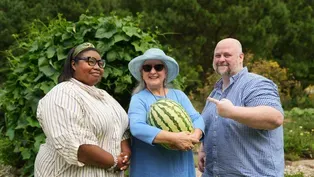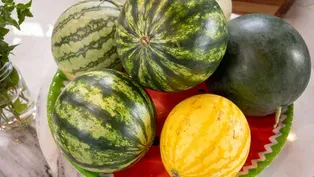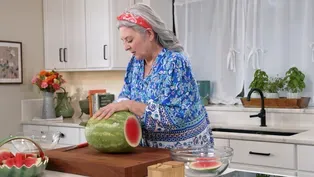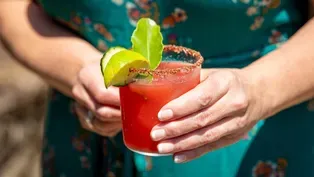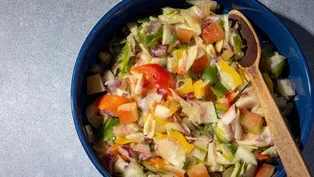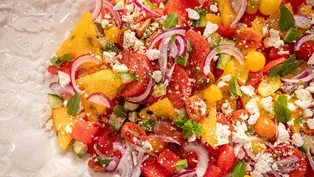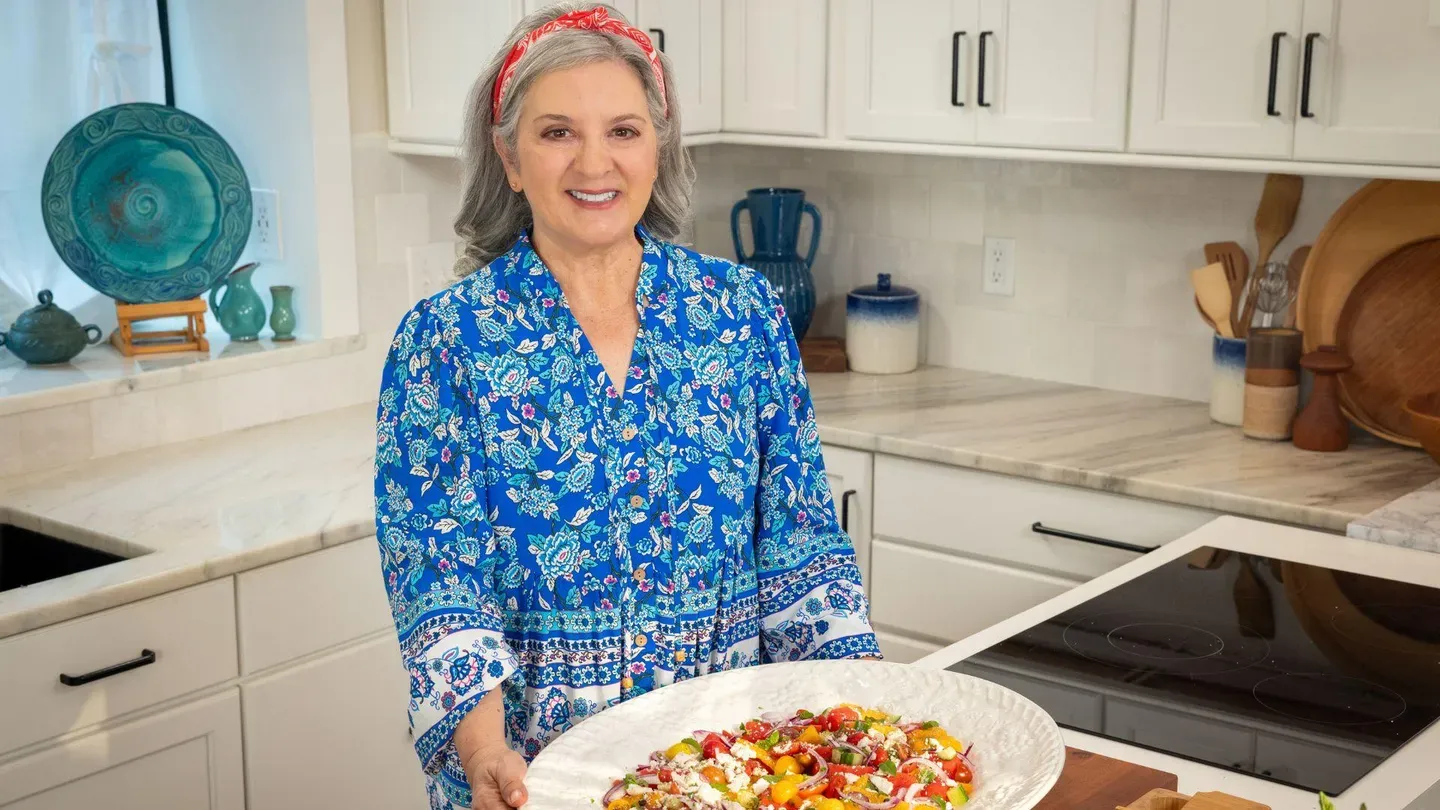

Watermelon Vibes
10/1/2024 | 26m 46sVideo has Closed Captions
Host Sheri Castle embraces summer and shares her favorite ways to make the most of watermelon.
Sheri visits an heirloom watermelon patch in Virginia with food historian Debra Freeman and journalist Joshua Fitzwater. She shares her recipe for a watermelon salad and a fascinating way to make watermelon rind pickles and slaw. Rock star chef Cheetie Kumar mixes up a refreshing watermelon and cucumber cooler cocktail, and Sheri demonstrates the most approachable way to cut up a watermelon.

Watermelon Vibes
10/1/2024 | 26m 46sVideo has Closed Captions
Sheri visits an heirloom watermelon patch in Virginia with food historian Debra Freeman and journalist Joshua Fitzwater. She shares her recipe for a watermelon salad and a fascinating way to make watermelon rind pickles and slaw. Rock star chef Cheetie Kumar mixes up a refreshing watermelon and cucumber cooler cocktail, and Sheri demonstrates the most approachable way to cut up a watermelon.
How to Watch The Key Ingredient
The Key Ingredient is available to stream on pbs.org and the free PBS App, available on iPhone, Apple TV, Android TV, Android smartphones, Amazon Fire TV, Amazon Fire Tablet, Roku, Samsung Smart TV, and Vizio.
Providing Support for PBS.org
Learn Moreabout PBS online sponsorship- [Announcer] This program was funded in part by The Forest at Duke, a retirement community in the heart of Durham, North Carolina.
With more than 350 residents, The Forest at Duke presents residents with ongoing opportunities to keep growing.
[cheerful music] - Coming up on "The Key Ingredient," we're welcoming watermelon into the kitchen, from a sensational salad, to clever ways to use the tasty rind, to a refreshing cocktail that's pretty in pink.
You know, I love hanging out with you.
You make everything delicious and fun.
What a great drink.
We're making the most of one of summer's favorite treats.
That's next.
[cheerful music ends] I'm Sheri Castle.
I write cookbooks.
I write for food magazines.
I cook, I teach, and I collect stories.
And my favorite stories are the ones behind our best loved home recipes.
That smells good.
You think bears are gonna come?
- Probably out here.
- [Sheri] Oh, that's awesome.
I will go out and explore from the ground up the best ingredients that go into some of our most beloved family recipes.
It's all about the food, the flavors, and finding "The Key Ingredient."
[cheerful music] I already knew that my friends, Deb Freeman and Joshua Fitzpatrick, were experts in southern food ways.
So imagine my surprise and delight when I discovered they're also passionate about heirloom watermelons.
Today we join them in a gorgeous garden in Virginia's Tidewater region to learn all about the famed red and sweet watermelon.
Hello, hello, friends.
- Hey, Sheri.
- Good morning.
Good morning.
- Good morning.
- How are you?
- Great.
Good to see you.
- Oh, it's always a pleasure to see you.
- Yes, yes.
- Hello, Sheri.
- Fitz, buddy.
- How're you doing?
- Great to see you.
So here we are in this amazing garden, and I hear that this is one of the spots that you guys have decided to grow some watermelons.
Do I have that part right?
- That's right.
- Okay.
Now I think our watermelons are right over there.
So will you let me tiptoe through your watermelon patch?
- We can do that.
- All right, let's do it, friends.
[bright music] So guys, for people that meet watermelons in the store, there's more to it than little bitty, medium, and big.
So what kind of watermelon are we visiting today?
- We are checking out the red and sweet.
And so the reason why you're not gonna see this in a grocery store, these are heirloom, like you said, which means they're at least 40 to 50 years old, the breed is, - Tell me about the red and sweet.
When I started investigating watermelons and then came across you guys, which I had known through other ways, I read that you have been known to like, take vacation days and four tanks of gas and do these odyssey in pursuit of watermelon flavor.
- Yeah, I've pretty much dragged Deb across the east coast of the United States.
- Yeah.
- To try to find the best heirloom watermelons.
And so she's been grumpy about it, but at the end of the day, [Deb laughs] she does like the taste of watermelons.
- What about the watermelons in general have intrigued you so much?
- Yeah, I think what's so interesting is there are stories behind watermelons.
Because it's never really about the watermelons, it's the story behind it.
Tasting this and tasting history, it really was absolutely worth it, because this watermelon you could only find in Monroe Parish in Louisiana.
- Really?
- And so it was just such a rare find to come across something like this and then be able to taste it, to crack it open.
We're almost like detectives in that way.
- Watermelon detectives.
- Yeah.
- And you've sort of become what I'm now calling the Johnny Watermelon seed of the Southeast.
- We've also been known to be called the heirloom hunters.
A horticulturalist, Kerry Hefner, had posted a thing online that he had essentially saved this breed.
He had met this old lady that had 'em in this tin can, the seeds.
And so he grew 'em out and found out through the records there in that area that this was the coveted red and sweet that had pretty much almost been lost in time.
- So do you see a ripe one ready for us to pick?
And by us I mean you.
[bright music] - [laughs] Yeah, this one I just cut, and this one, this one I believe we had the tendril, - Right.
- And we have the umbilical wear.
So I think we can pull this one out and we're good to go.
- Okay, let's go see if we can find a shady spot.
- Got it.
- All right.
[Joshua grunts] [bright music] Look at that.
Woo, that's pretty.
That is pretty.
Onward we go.
[upbeat music] Your expertise is more in the growing of them and all that.
But Deb, you know a lot about culinary history.
I mean, you're a real expert.
Tell me where watermelons came from.
- Watermelons, you know, they really come from West Africa.
They come from Spain.
So watermelons get to America via enslaved people.
I'm always so interested in watermelons because I'm from the south.
They were very prevalent in the south.
And so one of the cool things that I think not a lot of people may know is that enslaved people really were responsible for a lot of the growing of watermelons.
- Are you literally ready to taste the best watermelon that you've ever had?
- I don't believe that I could be any more ready.
- Okay.
- Let's go.
- Every day of my life has led to this.
[Deb laughs] Uh-huh.
Can you hear it?
Can you literally hear like the way- - I can see the juice flying outta it.
- Yeah.
- Ooh!
- It was ripe.
- Isn't that something?
- Yeah, it's gorgeous.
- They organize themselves.
I mean, it's like, you know.
- Right, and then in the middle's the heart where you'll find less seeds.
- So yeah, we're literally gonna give you a bite from the heart.
And the key thing with this is that station, the Calhoun Research Station, literally started in like, 1880 something.
- Really?
- Then the breeding program for watermelon starts in the 1950s.
And then it goes on to the '80s.
And this is the very last one that they produced in the '80s.
You're eating, you know, a hundred year plus history right now.
- It's literally repeatable history.
I mean, you're one of the things that, and that's what I was saying when we were talking earlier, you got to eat it to save it.
Because if the last person who knew that flavor, that knew that treasure was gone, we would have no reason to know we needed to keep growing it.
- Alright, here you go.
- Oh my goodness.
- And this is the only way, you don't- - Okay.
- Slice these thin.
- [Sheri] Love it.
Alright, friends.
- We gotta do a cheers.
We gotta do cheers.
- Alright.
- Absolutely.
Alright, here we go.
- You ready?
[bright music] - Oh my gosh.
- That is good.
[all laughing] [bright music] - This is like the hopes and dreams of all melons in one bite.
I mean, it's insanely juicy.
It's sweet, but not sugary.
- Mm-hmm.
- I mean, it's fruity, it's floral, but the texture I think that is hard to imagine something could be that much better or that good until you have a bite and is like, yep, the work was worth it.
- It is the story of that community for sure.
- Yes.
Yes.
- As you said about community, this watermelon is the story.
- And as you said from the beginning, it's the watermelon, but it's really the story of a watermelon that makes it special.
- Absolutely.
- And y'all are mighty special.
I got to hang out with you today.
Eat the best watermelon with two experts.
It was worth being out on this hot muggy day, wasn't it?
- Are you coming with us on the next 14, 17 hour trip that we got?
- Oh yeah.
I am, I am.
Yes, but I pick the tunes, man.
[all laughing] I pick the tunes.
- Alright.
- I can cosign on that.
- Alright.
[all laughing] Thanks, y'all.
Alright, this was great.
[bright upbeat music] [twangy music] You know what I love?
I love when a key ingredient gives me a great reason to fall back in love with it for all new reasons.
And that's what I'm gonna share with you now.
We all know about the joy of the inside of a watermelon.
Did you know there are things we can do with the outside too?
Yes, that rind is delicious.
And I'm gonna show you a two part recipe that is going to make you want to use the outside as well.
We're gonna start with a brine, a pickling brine, that is one part vinegar in a hot pan and an equal amount of water.
And into that granulated sugar.
And I'm going to let that cook just until that sugar dissolves.
Now for flavor in this delicious syrup, I'm going to add some strips of fresh lemon zest, some fresh ginger.
You don't even have to peel it, just slice it.
I'm going to put in three other spices.
What we have here is a mixed pickling spice.
Now you're gonna find this in the grocery store.
It's just called pickling spice.
And it's a beautiful blend of things like whole allspice and some clove and some bay, mustard seeds, sometimes some red pepper flakes.
And just by buying that one little jar, we're adding all of that flavor, that deliciousness, and an amazing aroma to our brine.
Some black peppercorns, and of course some salt.
Now I want this to come to a bit of a simmer.
And so as soon as the sugar dissolves, and you can tell that this is warm, 'cause that warmth is going to release all those spices, almost like making a cup of tea, we're gonna remove it from the heat.
And I am going to add one more thing.
And this is vanilla bean paste.
And I'm gonna let this stay warm, just a little bit, on low heat and show you what to do with this watermelon rind.
Now what I've done is, is I have taken away all but the thinnest little whispery layer of the pink.
[bright music] The pink is good to eat, but it's not good in a pickle.
So I'll leave a little bit for color, but not too much.
And we also don't want the very outside skin.
So all you need to do is to take a peeler and just take away that little bit of that outside part down until you're down to the peeled green part.
Once you've got it peeled, look, all you have to do is take your knife and make yourself some little cubes.
You don't even have to measure it.
You can eyeball it.
And look, I'm gonna add this to the bowl with my other bits that I've already cut up.
Last step, easy as can be.
I'm gonna put this warm brine over this.
Now, there's just enough warmth in this brine for the pickling action to begin without cooking my watermelon rind and turning it mushy.
I'm gonna let it sit here on my counter until it cools to room temperature, until I can feel it and I'm not perceiving any warmth.
Then I'm going to transfer this into jars.
My pickles have cooled off to room temperature and I'm gonna transfer them to the jars.
So I'm going to use my funnel and I am going to start by putting solids in the jar.
And you want your jars not cram full, but pretty full.
Take advantage of the space you have in the jar.
And then I am going to start adding liquid.
And I'm mainly now adding brine to top this off.
And you'll see when you think that the liquid is about at the top.
[bright music] And then I'm gonna take a chopstick and you really wanna work this down a little bit to make sure that there aren't any little hidden air pockets or anything.
All you have to do is close up the jar and stick this in the fridge.
Now let these guys sit for a day or two.
You can eat them tomorrow, but if you can give them three days or even a week, each day the flavor gets a little bit deeper, a little more pickling, and then they will keep beautifully in the refrigerator for a few weeks for snacking and for the recipe that I'm gonna show you next.
So this is part two of the great recipe that began with our watermelon rind pickles.
And it features even more rinds that I'm gonna turn into this colorful, crisp, amazing slaw.
Now it's gonna make quick work if you could shred your vegetables in a food processor.
If you don't have one, you can use a box grater or a sharp knife.
But what I've done here is put a very thin slicing disc in here and I'm gonna turn it on and drop my vegetables in.
I have our watermelon rind, I have got sweet bell pepper, I've got green bell pepper and some red onion.
And that's easy, just gonna feed it through.
And there we go.
Just that quick.
We're gonna salt these things.
So I'm gonna take our beautiful, colorful bits of veg, put it in a sieve sitting in a bowl to collect the drips and I'm gonna toss it with salt.
The salt is doing two simple, but important things.
One, it's seasoning everything, but it's also encouraging these vegetables to release their excess moisture.
And I'm just gonna let it sit for 15 minutes and the excess moisture will drip off leaving me crisp vegetables that are ready for the dressing that I'll show you next.
[bright music] So 15 minutes later I've got to show you what has happened.
Look at the amount of liquid that has come out of these vegetables.
Imagine if we left all that in there.
It would dilute all of our dressing.
So I am going to bring back some of our delicious pickles that we made earlier and they're gonna go right in there.
And then I'm gonna make a simple dressing.
I'm gonna take about a quarter cup of the watermelon rind pickle brine.
And if any of the little hard spices go in there, do take those out 'cause they provide flavor but they're too crunchy to chew.
And then I've got a couple of tablespoons of a neutral oil, something like canola oil.
And I'm gonna stir that together.
And just those two things is all you need for a dressing.
Now I'm gonna add quite a bit of black pepper, but I don't need any more salt because that salt that we put on the vegetables did all the seasoning that we need.
And we're gonna toss this up.
And just like that, you have watermelon rind slaw.
Now this is perfectly ready and completely delicious to eat right now, but if you have leftovers, I want you to put them in an airtight container in the refrigerator.
This is going to transform into almost a relish that you can put on a hot dog or a sandwich or on a plate.
Who knew that a good old watermelon rind, something we've been tossing away, could be the star ingredient in this amazing slaw and in a pickle jar?
Don't toss 'em anymore, eat 'em up.
[upbeat music] [bright music] My delightful friend, Cheetie Kumar, interprets local ingredients through the eyes of someone who grew up in India, New York City, and the American South.
Everything she makes sparkles with flavor and creativity.
Today she shows us how to stir up a gorgeous watermelon cocktail with a spice kissed rim.
[bright music] Hey.
- Hey.
- How's it going?
- It's great now.
- I know, we're back together again.
I'm team's back together.
So what do you have in store for us today?
- Well, this is a post-traumatic beverage that [chuckles] I made up in the summer of 2020.
- Uh-huh.
- And it kind of got us through that summer.
- Right.
- And it doesn't always have to have booze, but it was a reward.
- But it does when it's necessary.
- Yes, exactly.
You know, most fruit based cocktails are based on syrups.
- [Sheri] Mm-hmm.
- So I'm gonna make a syrup, but basically I'm just gonna let the juice of the watermelon, I'm gonna enhance it with a little sugar.
- Uh-huh.
- So that'll just make a very quick, raw syrup.
So there's no heat involved in this because it's summer.
- Oh, I like that.
It keeps that freshness and all that.
- Yes.
Yeah.
- Alright, show me how I do this.
- So it's really simple.
- Mm-hmm.
- You take watermelon, and first, I'm not gonna add the sugar right away, but I'm gonna make like, just a juice.
- Okay.
- So I'm just gonna puree it.
- Okay.
- And then we'll strain it.
We'll add sugar and that's it.
[blender whirs] - [Sheri] Would you look at that?
Look at the color of that watermelon syrup.
So what's the pretty green one?
- So we made a cucumber syrup.
- Same way?
- That's the same way.
- [Sheri] Okay.
- Because they're related.
- Yes, they are, botanically- - I figured they wanna hang out with each other.
- Right.
- I can believe that.
- And you know, watermelon is so sweet.
- [Sheri] Right.
- And you know, I don't like my cocktails super sweet.
And the cucumber really like, adds a nice freshness.
- What kind of booze are we using?
- This is gin.
Today's gin but, you know, you can use any clear spirit really.
I wouldn't use bourbon with this, but anything that's like clear- - Okay.
- And, you know, sharp.
- Great.
And I see all kinds of interesting things on this plate.
What are we gonna do with this?
- Well I love a rim on a cocktail.
- Mm-hmm.
- I think it can really, it's like the vinegarette to a salad.
- Yes.
- You know, you can really change the experience of a cocktail by the rim and the garnish.
So I love cumin with watermelon, black pepper because it's watermelon.
- [Sheri] Mm-hmm.
- But I thought it'd be fun to like, play with some other rims.
But while we talk about that- - Yes.
- I'm gonna get these toasting.
- Looks like you've got just a skillet.
A hot- - Yep.
- Dry.
- Plain skillet.
Dry skillet.
- Yeah.
- You don't want any fat in this.
- [Sheri] Okay.
- And just pop it in there.
I'm gonna throw the peppercorn in there because it is also a seed that improves with heat.
You know, you don't have to do much, but once you start smelling it, you do wanna shake the pan around.
- Oh, I love that.
Suddenly just whoosh, it just came out.
- Yeah, can you smell it?
It's incredible.
- Absolutely.
- So one thing to note, like when you're, you know, we're gonna grind it in a mortar and pestle, you could use a coffee grinder, but you wanna wait till the seed cools down.
[light music] - While this cools off, tell me about this one.
I'm so intrigued.
I think I know what that is, but I'm almost afraid to make a guess.
- This is sumac and it's a combination of sumac and Aleppo pepper.
This has gotta be good now I think.
Yeah.
See how it's like nice and it's really- - And that's such an important thing.
It's those little things.
If you're gonna take the time to do things, do 'em right.
- [Cheetie] And you can do it as fine or as coarse as you want.
- Alright, I'm gonna call.
- [Cheetie] That smells so good, doesn't it?
- I can't get over how much aroma is being released from this.
So I'm gonna give this to you.
- Okay.
We're gonna put the rest over here.
This is a nice, like flaky- - A garnish.
- Sea salt, yeah.
- [Sheri] Mm-hmm, mm-hmm.
- [Cheetie] I love this stuff.
- So is this lime juice?
- This is lime juice, yeah.
- Okay.
- So yeah, let's mix up a cocktail.
What do you think?
- Let's do that.
- So yeah, let's start with an even dip.
- Mm-hmm, mm-hmm.
- But again, you can go down the side if you want to.
And I'm just gonna go all the way around.
- So now we're gonna start building our cocktail.
- Yeah.
- What comes next?
- Let's go in the cocktail shaker.
- Okay.
Alright.
- And because we're fancy, as we've established last time.
- [Sheri] So fancy.
- We're gonna use these lime leaves, drop 'em in there.
Obviously if you don't have this, you don't have to worry about it or use it.
- I love that.
And so you're just muddling.
You're just smashing in to crush some of those cell walls and release that flavor.
- Wake 'em up a little bit.
Now let's put some ice in there.
- Okay.
- Like maybe a third or halfway full.
Let's just start building.
- Uh-huh.
- I'm not even gonna measure, I'm gonna eyeball.
But you're basically like maybe two and a half ounces of watermelon- - Okay.
- Syrup.
A little bit less of the cucumber.
A little bit of lime juice.
- Okay.
- And would you like some gin?
- Mm-hmm.
[upbeat music] [shaker rattles] - It's important to shake it hard and then just top it off with this soda water.
- [Sheri] Mm-hmm.
- And you can go as fancy as you want with your garnishes.
- Okay.
- You could put mint on here.
You can do the cucumber, you can put a wedge of watermelon, whatever floats your boat.
- Okay.
Let us get this up here.
[upbeat music] - Cheers.
- Cheers.
[upbeat music] Oh wow.
Watermelon, I mean, this is a watermelon thing.
The cucumber's almost like an aroma.
- [Cheetie] Yeah.
- But there's the balance.
It's sweet but not sugary.
You get the aroma from the spices and our garnishes.
My goodness, what a great drink.
- Let's mix up a pitcher.
- A whole pitcher and go find a porch.
- Love it.
- That sounds good.
You know, I love hanging out with you.
You make everything delicious and fun.
- I always learn so much from you and it's always a pleasure.
- Always a pleasure.
- Thank you.
- Let's toast to the next time.
- Yeah.
- Alright.
[upbeat music] So today I'm going to make a watermelon salad that, of course, stars watermelon, but has some other delicious things to go on it.
So let's start with our watermelon.
You know, watermelon's gonna taste pretty much the same, no matter what shape it's cut into.
But why not have fun with this?
Why not give yourself a chance to play and be creative?
I took some pieces of watermelon and a biscuit cutter and a cookie cutter and I just stamped out different sized pieces.
Now look at this watermelon.
This watermelon is yellow.
Yes, there are yellow watermelons.
Matter of fact, there are white flesh watermelons.
There are all kinds of watermelons for us to explore and to try.
Look at this over here, friends, look at this.
Everything we have here is a kind of watermelon.
These are fairly small, but you'll notice that they have different kinds of stripes and different colors.
Explore, go to your farmer's market, go to your local vegetable stand, look around and try different things.
It's how you take a familiar ingredient and make it feel fun.
It's how you learn new flavors.
But back to this, we're gonna keep building.
This is some cucumber.
You know, cucumbers and watermelons and squashes and pumpkins are all cousins.
And when you think about that, it's like, yeah, look how they grow.
I bet they are related.
And then we have tomato.
Now I'm using these lovely, little multicolored cherry and grape and teardrop tomatoes.
Just a few on there.
And then I'm going to put some red onion.
I love the beautiful color of these pieces of red onion.
And then a little bit of jalapeno, just a tiny little bit of spice.
Now obviously, if you want a little more kick, you can use a spicier chili.
But this jalapeno is probably just right.
This is something called ricotta salata.
Now we're nearly finished with this, but I need to make a dressing.
I'm gonna take my little bowl here and I'm gonna put three things in here.
This is fresh lime juice and we have a little bit of tequila.
Yes, I am building a margarita-inspired dressing for this salad.
And this is a little bit of an orange liqueur.
And just whisk that up.
[whisk tapping] And I'm gonna drizzle this over the top.
This is a fun dressing.
[upbeat music] We're adding citrus, we're adding flavor.
Three more little things.
I have got some coarse sugar.
A little bit of sugar will bring out the natural sweetness in what we have on the platter.
And then some good coarse salt, like you would rim a margarita serving glass with.
Beautiful crunchy salt.
I'm gonna put a bit of fresh mint.
And my last thing, this stuff that looks like black pepper is actually called black lime.
And just a little sprinkle over the top is what you need for that final burst of bright lime flavor in a great new way to serve that.
And just like that, look what we've done.
Right on the serving platter we have assembled this gorgeous watermelon rich salad.
This is a recipe that people are gonna love throughout the season.
It is so easy and you need to add it to your recipe box.
[upbeat music] [bright music] So let's talk about cutting up a watermelon.
They are large, roly-poly, wobbly things.
And so I wanna show you how I stabilize them to have a little more control of the cuts I'm making.
So I'm gonna take a serrated knife, maybe like you would use for bread, a good serrated knife, and I'm gonna cut off one end.
Got a bowl here to collect this.
And I'm gonna turn it around.
I'm gonna do the same thing on the other end.
I usually make one more cut down the middle.
You wanna try to get this even.
So I'm gonna rotate this a little bit.
Cut that until it comes in half, you can hear it.
And now I've got two pretty even halves that are stable on my cutting board.
Now I'm gonna go down from the top and start cutting off these big outside pieces.
We're just gonna go around and around and take this off.
And two more cuts and then we're gonna make ourselves some nice big chunks.
So I'm gonna go down from the top, cut straight down.
Turn that around like that.
Turn this here.
I'm gonna do the same thing from the other direction, making ourselves a little grid.
And look what we have.
We now have more or less rectangles of watermelon.
It really is easy.
It really is quick.
And this means you don't have to buy those expensive cups of pre-cut watermelon 'cause you know how to do this yourself.
It's easy.
[bright music] [light twangy music] From their crisp rinds to their sweet centers, a juicy, ripe watermelon is good through and through, and it's sure to be the key ingredient in your next recipe.
- [Joshua] You can see, whenever I've cut other watermelons, look at the sugar that you can see in the cuts.
- [Sheri] Absolutely, it's like syrup.
- Yep.
- With little bits.
[Joshua chuckles] [light music] For all the recipes from the show, visit our website.
[gentle music] - [Announcer] This program was funded in part by The Forest at Duke, a retirement community in the heart of Durham North Carolina.
With more than 350 residents, The Forest at Duke presents residents with ongoing opportunities to keep growing.
[bright music]
Field Trip to an Heirloom Watermelon Patch
Video has Closed Captions
Sheri Castle heads to Irvington, Virginia, to explore the rich heritage of heirloom watermelons. (6m 1s)
Video has Closed Captions
Host Sheri Castle embraces summer and shares her favorite ways to make the most of watermelon. (30s)
Sheri Says: How to Cut Up a Watermelon
Video has Closed Captions
Host Sheri Castle demonstrates the easiest, most approachable way to cut up a watermelon. (1m 41s)
Watermelon Cocktail | Cook Along with Cheetie Kumar
Video has Closed Captions
Sheri joins chef Cheetie Kumar as she mixes up a delightfully refreshing watermelon cocktail. (6m 3s)
Watermelon Rind and Refrigerator Pickle Slaw | Kitchen Recipe
Video has Closed Captions
Sheri shares her recipe for watermelon rind and refrigerator pickle slaw, a twist on a classic side. (7m 39s)
Watermelon Salad with Margarita Dressing | Kitchen Recipe
Video has Closed Captions
Sheri prepares a watermelon salad with margarita dressing that is as vibrant as it is refreshing. (3m 36s)
Providing Support for PBS.org
Learn Moreabout PBS online sponsorship